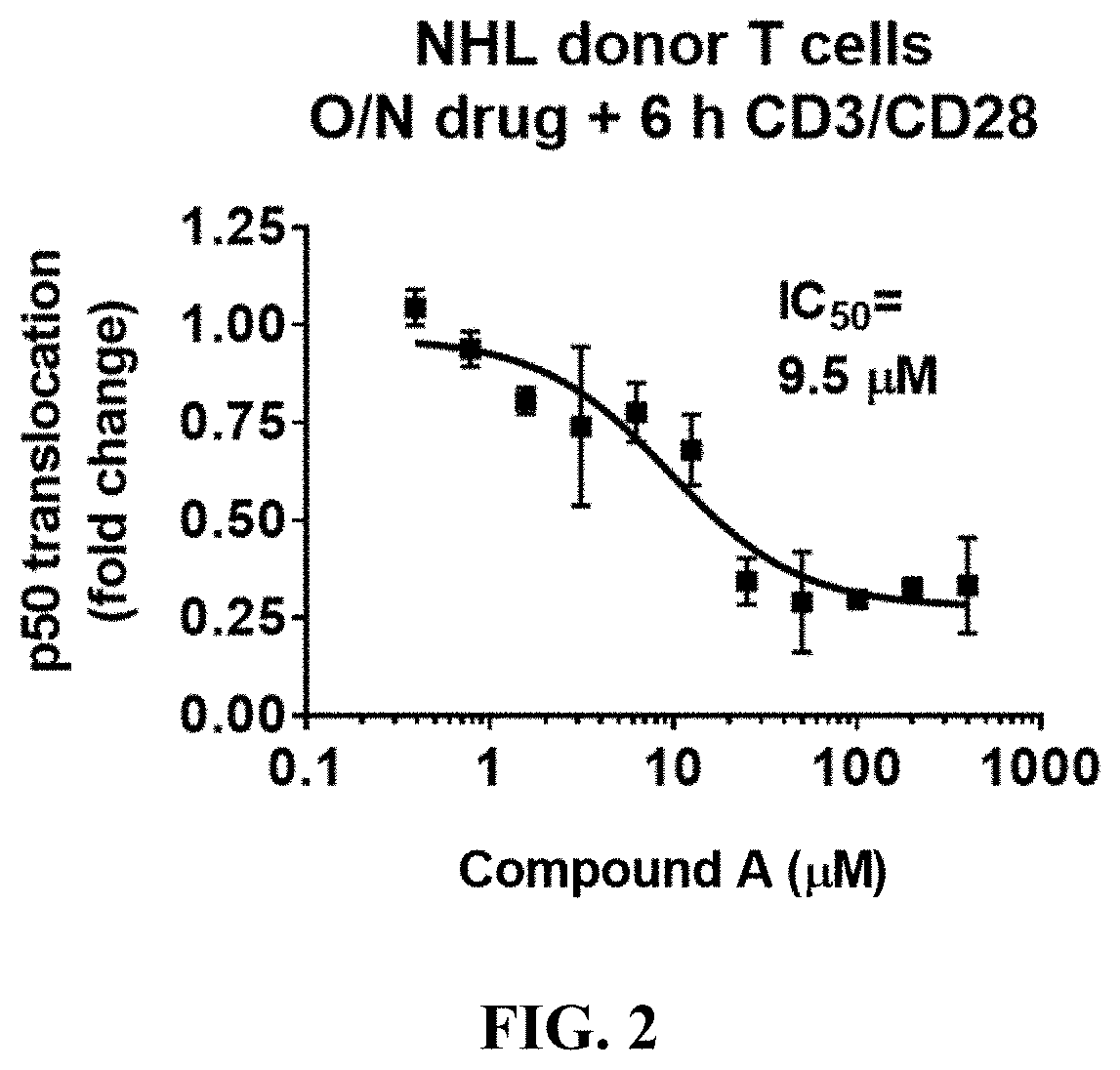Methods for assessing efficacy of malt1 inhibitors using an nf-kb translocation assay
a technology of nf-kb and malt1 inhibitor, which is applied in the field of nf-kb translocation assay, can solve the problems of major challenges in the detection of nuclear translocation of nf-b or the measurement of nf-kb target gene expression in tumor cells, and achieve the effect of increasing reducing the dosing frequency of malt1 inhibitors
- Summary
- Abstract
- Description
- Claims
- Application Information
AI Technical Summary
Benefits of technology
Problems solved by technology
Method used
Image
Examples
example 1
tivation and PBMCs Isolation for NFκB Nuclear Translocation Assays
[0184]Samples of whole blood (40 mL) were obtained from lymphoma donors in four-10 mL Heparin tubes. The samples were shipped overnight at ambient temperature from Conversant Bio (Huntsville, Ala.) collection sites. However, subsequent evidence in the lab suggested that shipping at 4° C. may better preserve the responsiveness of the cells.
[0185]Each of 6.5 mL of the whole blood sample was transferred to two 50 mL conical tubes (Corning, cat. #430290; Corning, N.Y.) and mixed 1:1 with room-temperature 1640 Roswell Park Memorial Institute (RPMI) with 25 mM HEPES (Life Technologies, cat. #72400-047), supplemented with 10% HI Fetal Bowine Serum (FBS) (Life Technologies, cat. #16140-071; Carlsbad, Calif.). One of the 50 mL sample containing conical tubes was treated with 200 μM Compound A (200 mM stock; 1000×) and the other 50 mL conical tube was treated with an equivalent volume of vehicle control DMSO (Life Technologies,...
example 2
lear Translocation in T or B Cells by Imaging Flow Cytometry
[0190]Frozen or fresh cells treated with the experimental conditions were obtained. For example, T cells in blood samples could be activated and the PBMCs containing the activated T cells could be isolated using the method described in Example 1. Alternatively, PBMCs in blood samples could be activated and subject to the imaging flow cytometry analysis directly without isolation. If the samples were whole blood, a minimum of 1 mL of blood was used for each test in this experiment. However, less than 1 mL whole blood can also be used in the assay. If the samples were frozen, the samples were thawed at 37° C. and gently washed in room-temperature PBS (Life Technologies, cat. #14190-136) by centrifugation at 1350 rpm for 5 minutes.
[0191]The cells were stained for surface markers, such as CD4 (Miltenyi, cat. #130-092-373; Bergisch Gladbach, Germany) and CD8 (BioLegend, cat. #301050) (for T cells) or CD19 (BioLegend, cat. #30220...
example 3
ession Analysis on T Cells from Peripheral Whole Blood Samples of Normal and NHL Patients
[0198]Peripheral whole blood from normal and NHL donors was treated with 200 μM Compound A or left untreated and incubated at 37° C. overnight. The next day, blood was treated with anti-CD3 and anti-CD28 stimulatory antibodies for 6 hours as described in Example 1 or left untreated. After treatment with the stimulatory antibodies, the red blood cells were lysed using multi-species lysis buffer, and the white blood cells were stained with anti-CD4 and anti-CD8 antibodies to label T cells and an anti-CD69 antibody to measure early T cell activation. Frequency of CD69-positive T cells (CD4+ and CD8+) was measured by IFC.
[0199]As shown in FIG. 1A, incubating the normal blood sample with anti-CD3 and anti-CD28 stimulatory antibodies resulted in an increased surface expression of CD69 on CD4+ and CD8+ T cells, and such increase was not affected by the treatment with Compound A. However, as shown in FI...
PUM
| Property | Measurement | Unit |
|---|---|---|
| volume | aaaaa | aaaaa |
| concentration | aaaaa | aaaaa |
| concentration | aaaaa | aaaaa |
Abstract
Description
Claims
Application Information
 Login to View More
Login to View More - R&D
- Intellectual Property
- Life Sciences
- Materials
- Tech Scout
- Unparalleled Data Quality
- Higher Quality Content
- 60% Fewer Hallucinations
Browse by: Latest US Patents, China's latest patents, Technical Efficacy Thesaurus, Application Domain, Technology Topic, Popular Technical Reports.
© 2025 PatSnap. All rights reserved.Legal|Privacy policy|Modern Slavery Act Transparency Statement|Sitemap|About US| Contact US: help@patsnap.com



